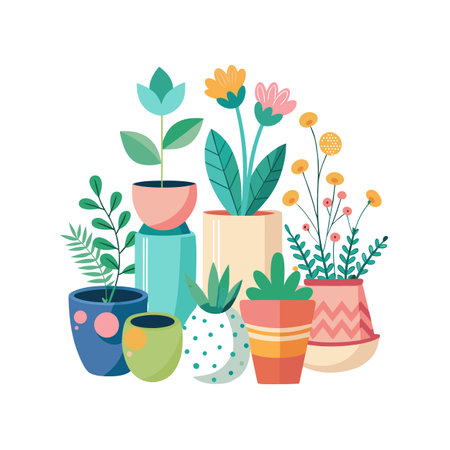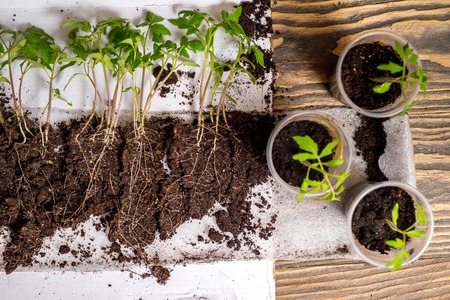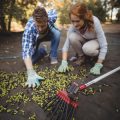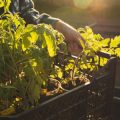1. Getting Started with Seasonal Organic Gardening
Organic gardening is a great way to enjoy fresh, healthy produce while caring for the environment. Whether you’re a first-time gardener or looking to switch to an organic approach, understanding the basics is the key to year-round success in your U.S. garden.
Choosing the Right Site
Selecting the perfect spot for your garden is essential. Look for an area that gets at least 6-8 hours of direct sunlight daily, has good air circulation, and is close to a water source. Avoid spots where water tends to pool after rain, as soggy roots can harm your plants. If space is tight, raised beds or containers can work well too.
Building Healthy Soil
The heart of any organic garden is its soil. Instead of relying on synthetic fertilizers, focus on building rich, living soil full of beneficial microbes and nutrients. Regularly adding compost, leaf mulch, or aged manure helps boost soil health naturally. To know what your soil needs, consider a simple home soil test kit or reach out to your local county extension office.
| Soil Amendment | Main Benefit | How Often to Add |
|---|---|---|
| Compost | Adds nutrients & improves texture | 2-3 times per year |
| Leaf Mulch | Retains moisture & suppresses weeds | Once per season |
| Aged Manure | Nitrogen boost & microbial life | Annually (in fall or early spring) |
| Organic Fertilizer Mix | Balances soil nutrients as needed | Follow package instructions |
Essential Tools for Organic Gardeners
You don’t need a garage full of gadgets to get started! Here’s a basic toolkit for U.S. organic gardeners:
- Garden gloves: Protects hands from thorns and soil microbes.
- Trowel: Handy for planting and weeding.
- Spade or shovel: For digging larger holes and turning soil.
- Hoe: Helps with weed control between rows.
- Watering can or hose with spray nozzle: Provides gentle watering for young plants.
- Pruners: Essential for trimming herbs and harvesting veggies.
- Wheelbarrow: Makes hauling compost and mulch much easier.
Tip:
If you’re gardening in colder climates, consider season extenders like row covers or cold frames to keep your harvest going longer into the year!
2. Spring: Soil Prep, Planting, and Early Care
Month-by-Month Guide for Organic Gardeners
Spring is an exciting time for gardeners across the U.S. As the days get longer and the soil begins to warm, its time to roll up your sleeves and jump into action. Here’s a simple month-by-month breakdown to help you prepare your organic garden for a successful season.
March: Wake Up the Soil
- Test Your Soil: Check pH and nutrients with a home test kit or local extension service.
- Add Compost: Spread 1-2 inches of finished compost over your beds to boost fertility.
- Till or Loosen: Use a garden fork or broadfork to gently loosen compacted areas, being careful not to disturb soil life too much.
- Plan Your Layout: Sketch out your crop rotation and decide where each veggie will go this year.
April: Start Seeds Indoors & Outdoors
| Task | Indoor | Outdoor |
|---|---|---|
| Sow cool-season seeds (lettuce, kale, broccoli) | X | X (if frost-free) |
| Sow warm-season seeds (tomatoes, peppers) | X | |
| Transplant hardy seedlings (onions, cabbage) | X | |
| Add mulch to paths | X |
Tips: Use seed starting trays with organic seed-starting mix indoors. Keep seedlings under grow lights or by a sunny window for 12-16 hours a day.
May: Transplant & Protect Young Plants
- Transplant Seedlings: Move tomatoes, peppers, eggplants, and other frost-sensitive plants outdoors after all danger of frost has passed in your region.
- Harden Off: Gradually expose seedlings to outdoor conditions over 7-10 days before transplanting.
- Add Organic Fertilizer: Mix in slow-release organic fertilizer or more compost around transplants.
- Pest Patrol: Handpick pests like cutworms and use row covers to protect young plants naturally.
- Irrigation: Water deeply at the base of plants in the morning to keep soil moist but not soggy.
Organic Spring Troubleshooting Tips
- If weeds pop up early, pull them while theyre small or cover soil with straw or leaf mulch.
- If you spot aphids, spray with a gentle solution of water and a drop of mild soap, or attract ladybugs by planting dill or fennel nearby.
- If nights are still chilly, use old sheets or frost cloths to protect tender crops overnight.

3. Summer: Maintenance, Pest Control, and Harvests
Tips for Watering Your Summer Garden
Summer brings heat waves and long sunny days, so keeping your garden hydrated is essential. Early morning is the best time to water, as less moisture evaporates and plants can absorb what they need before the heat kicks in. Deep, infrequent watering encourages roots to grow deeper, making plants more drought-resistant. Avoid watering leaves directly to reduce disease risk—focus on the soil at the plant’s base.
Watering Tips Table
| Plant Type | Watering Frequency | Best Time to Water |
|---|---|---|
| Vegetables (tomatoes, peppers) | 2-3 times per week | Early morning |
| Herbs (basil, mint) | 1-2 times per week | Early morning or late afternoon |
| Fruit Crops (berries) | 2-3 times per week | Early morning |
The Power of Mulching in Summer
Mulching is a summer gardener’s best friend. Organic mulches like straw, grass clippings, or shredded bark help conserve moisture, keep soil temperatures steady, and block weeds. Spread a 2-3 inch layer around your plants, but keep mulch away from direct contact with stems to prevent rot.
Popular Organic Mulch Options Table
| Mulch Material | Main Benefits | Where to Use |
|---|---|---|
| Sawdust or wood chips | Long-lasting weed control; keeps soil cool | Around fruit trees and shrubs |
| Sawdust or wood chips Straw/hay clippings | Adds organic matter; easy to apply; breaks down quickly | Vegetable beds |
| Grass clippings | Nitrogen-rich; free if you mow your own lawn | Around annuals and garden beds |
Natural Pest Management Strategies
Pest problems peak in summer, but you can keep them under control without chemicals. Inspect your plants regularly for signs of trouble—holes in leaves, sticky residue, or discolored spots. Remove pests by hand when possible and attract beneficial insects like ladybugs by planting flowers such as marigolds or calendula nearby. Homemade sprays using ingredients like neem oil or diluted dish soap are safe for most edible plants.
Pest Management Quick Reference Table
| Pest Type | Organic Control Method |
|---|---|
| Aphids | Spray with soapy water; encourage ladybugs |
| Caterpillars | Handpick; use Bt (Bacillus thuringiensis) spray |
| Slugs/Snails | Lure with shallow dishes of beer; use copper tape barriers |
Harvesting Peak Produce in Summer
The real reward of summer gardening is harvesting fresh produce at its peak flavor. Check your crops daily—many vegetables like zucchini and beans can go from perfect to overripe in just a day or two. Harvest in the morning when produce is crisp and flavorful. Use clean scissors or pruners to avoid damaging plants and wash everything thoroughly before bringing it into your kitchen.
Summer Harvest Timelines Table
| Crop | DAYS TO MATURITY* | SIGN OF READINESS |
|---|---|---|
| Zucchini/summer squash | 45-60 days | Tender skin, 6–8 inches long |
| Cucumbers | 50-70 days | Bright green, firm, medium size |
| TOMATOES | 60-85 days | Fully colored, slightly soft to touch |
*Days may vary depending on variety and local conditions.
4. Fall: Succession Planting and Soil Enrichment
Best Practices for Extending the Growing Season
As temperatures start to cool, fall is a great time to keep your garden productive. With a few simple techniques, you can stretch your harvest well into the cooler months. Consider using row covers or cold frames to protect tender crops from early frosts. These tools trap heat and create a microclimate, allowing leafy greens, carrots, and radishes to thrive longer.
Succession Planting for Continuous Harvest
Succession planting means sowing new crops as soon as earlier ones are harvested. This keeps your beds full and productive. In most American climates, you can plant fast-maturing crops like spinach, lettuce, arugula, and Asian greens in late summer or early fall. Below is a handy guide for what to plant when:
| Region | Early Fall (Sept) | Mid-Fall (Oct) | Late Fall (Nov) |
|---|---|---|---|
| Northeast & Midwest | Spinach, Radishes, Lettuce | Kale, Mâche, Mustard Greens | Garlic (for next spring) |
| Southeast | Bok Choy, Swiss Chard, Beets | Carrots, Collards | Onions (overwintering) |
| West Coast & Pacific NW | Lettuce, Turnips, Broccoli Raab | Kale, Cilantro | Fava Beans (cover crop) |
| Southwest | Spinach, Peas | Radishes, Parsnips | Onions (short-day types) |
Transitioning Crops for a Healthier Garden Next Year
The end of the growing season is also about prepping for next year. Once summer crops have finished producing, remove plant debris to reduce disease and pest issues. Rotate crop families—don’t plant tomatoes where tomatoes grew last year—to avoid soil-borne problems.
Soil Enrichment: Building Healthy Foundations
Fall is prime time for improving soil health organically. Spread a layer of compost over your garden beds; this feeds soil microbes through winter and adds nutrients for spring planting. You can also plant cover crops like clover, vetch, or winter rye—these “green manures” prevent erosion and add organic matter when turned under in spring.
| Soil Amendment | Main Benefit | When to Apply |
|---|---|---|
| Compost | Adds nutrients & improves structure | After final harvest in fall |
| Cover Crops (Green Manure) | Adds organic matter & fixes nitrogen | Sow in early/mid-fall before first frost |
| Mulch (Leaves/Straw) | Protects soil & suppresses weeds | Spread after planting cover crops or on empty beds in late fall |
| Aged Manure (well-composted) | Slow-release fertilizer for spring growth | Add in late fall so it breaks down over winter |
Tending Your Garden Through Fall Pays Off Next Spring!
A little extra effort in the fall—succession planting, protecting crops from frost, rotating beds, and enriching your soil—sets you up for healthier plants and bigger harvests when spring rolls around again.
5. Winter: Rest, Planning, and Garden Care
Protecting Overwintering Crops
Winter might seem like a quiet season in the garden, but it’s important to look after any crops that are toughing out the cold. Many American gardeners grow hardy greens, root vegetables, or garlic through winter. Protect these overwintering crops with mulch, row covers, or cold frames to keep them insulated from freezing temperatures and drying winds.
| Crops | Protection Tips |
|---|---|
| Kale & Spinach | Layer straw mulch and use row covers for frost protection. |
| Garlic | Apply thick mulch to prevent soil heaving during freeze-thaw cycles. |
| Carrots & Beets | Mulch heavily; harvest as needed throughout winter if ground isn’t frozen. |
Garden Cleanup and Composting
This is the perfect time to clear out spent plants, dead annuals, and fallen leaves. Removing debris reduces pests and diseases that can overwinter in your garden. Add healthy plant material to your compost pile—avoid adding anything diseased or infested by insects. Remember to turn your compost pile every few weeks to keep it aerated and breaking down efficiently, even in cold weather.
Winter Composting Tips
- Shred leaves and stalks for faster decomposition.
- Add kitchen scraps like vegetable peels and coffee grounds.
- If your compost freezes, don’t worry—it will resume breaking down when temperatures rise.
Planning for a Successful Spring
While the garden rests, you can start dreaming about next year! Winter is prime time for planning ahead:
- Review last year’s successes and challenges: What worked well? What would you do differently?
- Order seeds early: Popular varieties can sell out fast, so get your orders in during winter months.
- Create a planting calendar: Map out when to start seeds indoors or direct sow based on your USDA hardiness zone.
- Clean and sharpen tools: Maintenance now saves hassle later!
Sample Monthly Winter Tasks Table
| Month | Main Tasks |
|---|---|
| December | Add mulch, review garden notes, order seed catalogs. |
| January | Plan crop rotation, clean tools, check stored produce. |
| February | Select seeds, start some transplants indoors, organize supplies. |
Your Winter Gardening Checklist:
- Tuck in overwintering crops with mulch or row covers.
- Tidy up garden beds and compost healthy debris.
- Dive into planning mode: dream big for spring!
6. Regional Considerations Across the U.S.
Understanding Your Climate Zone
The United States covers a wide range of climate zones, from the cold winters of the Northeast to the warm, humid summers in the South and the dry heat of the Southwest. Knowing your USDA Hardiness Zone is key for successful seasonal organic gardening. This zone tells you which plants are most likely to thrive in your area and when it’s safe to plant them outdoors.
USDA Hardiness Zones Overview
| Region | Zones | Main Climate Features |
|---|---|---|
| Northeast | 3-7 | Cold winters, late frosts, short growing season |
| Southeast | 7-10 | Mild winters, hot humid summers, long growing season |
| Midwest | 3-6 | Harsh winters, unpredictable springs, moderate summers |
| Southwest | 5-10 | Hot dry summers, mild winters, water scarcity issues |
| Pacific Northwest | 6-9 | Mild wet winters, cool summers, frequent rain |
| West Coast (California) | 7-11 | Mild winters, dry hot summers, Mediterranean-like climate |
Frost Dates: Planning Around Last and First Frosts
Your local frost dates—last frost in spring and first frost in fall—are crucial for planning planting and harvesting times. These dates can vary widely even within a single state! Always check your local extension office or trusted gardening resources for accurate frost dates.
Sample Monthly Gardening Planner by Region (Spring Example)
| Region | March Activities | April Activities | May Activities |
|---|---|---|---|
| Northeast & Midwest | Start seeds indoors (tomatoes, peppers) | Harden off seedlings; plant peas outside if soil is workable | Transplant hardy crops; direct sow lettuce & carrots after last frost date passes |
| Southeast & Southwest | Direct sow cool-season crops (lettuce, spinach); prepare soil for summer crops | Plant tomatoes and peppers outdoors; mulch garden beds | Sow beans and corn; watch for pests as temperatures rise |
| Pacific Northwest & West Coast | Sow peas and leafy greens outside; start warm-season crops indoors | Add compost; transplant brassicas outdoors | Direct sow summer veggies; set out tomatoes after danger of frost |
Tips for Tailoring Activities to Your Region
- Check Local Weather: Unseasonal cold snaps or heat waves can affect your monthly plans. Stay flexible!
- Select Suitable Varieties: Choose seeds labeled as “short season” for cooler regions or drought-tolerant varieties for arid areas.
- Adjust Watering: Increase watering during dry spells in the Southwest or decrease during rainy months in the Pacific Northwest.
- Pest Watch: Warmer regions may see pest activity earlier—set up row covers or organic deterrents as needed.
Your Local Extension Office Is a Great Resource!
If you’re ever unsure about what or when to plant, your county’s Cooperative Extension office can provide region-specific advice and help you make the most of your month-by-month gardening plan.
7. Organic Gardening Community and Resources
Connecting with Local Gardeners
One of the best ways to grow as an organic gardener is to connect with others in your area. Local gardeners can offer advice specific to your region’s climate, soil, and seasonal challenges. Consider joining a community garden, attending local gardening meetups, or participating in workshops at nearby nurseries. Many neighborhoods have Facebook groups or Nextdoor communities where you can share tips and ask questions year-round.
Recommended U.S.-Based Resources
| Resource | Description | Website |
|---|---|---|
| American Community Garden Association (ACGA) | Find community gardens and connect with gardeners nationwide. | communitygarden.org |
| National Gardening Association (NGA) | Offers gardening articles, Q&A forums, and local planting guides. | garden.org |
| Seed Savers Exchange | Nonprofit focused on seed sharing and preservation for organic gardeners. | seedsavers.org |
| Local Extension Offices | University-backed advice tailored to your state or county’s conditions. | USDA Directory |
Seed Exchanges and Sharing Opportunities
Participating in seed swaps is a fun way to discover new plant varieties and build a resilient garden. Many local libraries, gardening clubs, and farmers’ markets host annual seed exchanges. You can also find online seed swap communities on platforms like Reddit (r/seedswap) or through national organizations like Seed Savers Exchange.
Tips for Successful Seed Swapping:
- Label seeds clearly with variety and harvest date.
- Share seeds from healthy, disease-free plants.
- Respect swap guidelines and offer fair trades.
- Ask about locally adapted varieties for best results in your area.
Ongoing Learning for a Thriving Organic Garden
The world of organic gardening is always growing. Stay inspired by signing up for newsletters from trusted organizations, following U.S.-based gardening blogs, or subscribing to YouTube channels with seasonal tips. Consider taking online courses or attending webinars offered by botanical gardens or agricultural universities. Continuous learning will keep your garden flourishing through every month of the year!


